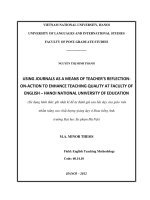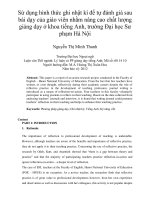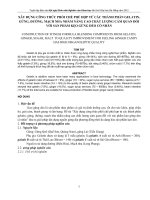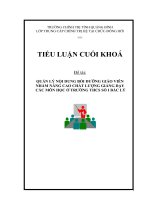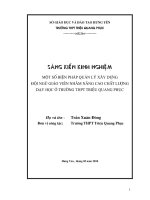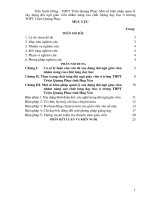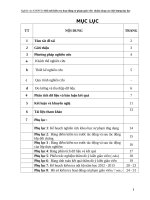Sử dụng hình thức ghi nhật kí để tự đánh giá sau bài dạy của giáo viên nhằm nâng cao chất lượng giảng dạy ở khoa tiếng Anh, trường Đại học Sư phạm Hà Nội
Bạn đang xem bản rút gọn của tài liệu. Xem và tải ngay bản đầy đủ của tài liệu tại đây (171.57 KB, 10 trang )
Sử dụng hình thức ghi nhật kí để tự đánh giá sau
bài dạy của giáo viên nhằm nâng cao chất lượng
giảng dạy ở khoa tiếng Anh, trường Đại học Sư
phạm Hà Nội
Nguyễn Thị Minh Thanh
Trường Đại học Ngoại ngữ
Luận văn ThS ngành: Lý luận và PP giảng dạy tiếng Anh; Mã số: 60 14 10
Người hướng dẫn: M.A. Hoàng Thị Xuân Hoa
Năm bảo vệ: 2012
Abstract: This paper is a report of an action research project conducted in the Faculty of
English – Hanoi National University of Education. From the fact that few teachers have
written, or even thought, reflectively during their academic careers despite the role of
reflective practice in the development of teaching profession, journal writing is
introduced as a means of reflection-on-action. Four teachers in this faculty voluntarily
participate in using journals to reflect on their teaching. Based on the data collected from
analyzing teachers’ journals and interview, it is found that writing journal could promote
teachers’ reflection on their teaching and helps to enhance their teaching practice.
Keywords: Phương pháp giảng dạy; Ghi nhật ký; Tiếng Anh; Kỹ năng viết
Content
PART I: INTRODUCTION
1. Rationale
The importance of reflection to professional development of teaching is undeniable.
However, although teachers are aware of the benefits and importance of reflective practice,
they do not apply it to their teaching practice. Concerning the use of reflective practice, the
research by Odeh, Kurt, and Atamtürk showed that “there is a gap between theory and
practice” and that the majority of participating teachers practice reflection-in-action and
ignore reflection-on-action – a deeper level of reflection.
The case of EFL teachers at the Faculty of English, Hanoi National University of Education
(FOE – HNUE) is no exception. As a novice teacher, the researcher finds that reflective
practice is of great value to professional development; however, from her own experience
and observation as well as discussions with her colleagues, this activity is not popular despite
the teachers’ awareness of its benefits. Reflection is especially of great significance because
teachers in this context are training teachers-to-be, and it is stated by Scales that “Reflective
teachers are more likely to develop reflective learners. If we practice reflection we can more
effectively encourage learners to reflect on, analyze, evaluate, and improve their own
learning.” (p.14)
Due to the importance of reflective practice in professional self-development and the above-
mentioned current situation, it is desirable to introduce activities to promote teachers’
reflection-on-action. In this action research, journal writing is introduced as a means of
reflection to hopefully enhance teachers’ reflective practice and teaching quality.
2. Aims of the study
This study is an attempt to promote teacher’s reflection-on-action in FOE-HNUE via the use
of journal writing. It will investigate the effectiveness of this activity and the teachers’
difficulties when using journals as a means of reflection-on-action.
To fulfill this purpose, the study aims to answer the following question:
How effective is journal writing as a means of reflection-on-action effective in
promoting teaching quality as perceived by teachers?
3. Scope of the study
This study focuses on enhancing teachers’ reflection-on-action of teachers at FOE – HNUE
using journal writing. Within its scope, the research aims at justifying the effectiveness of
using this means of reflection as perceived by the participants and investigating their
difficulties in their reflective practice.
4. Methods of the study
This study is conducted as an action research because it aims at promoting teachers’
reflection-on-action within a certain context, namely the Faculty of English, Hanoi National
University of Education. In order to fulfill that aim, journal writing is utilized by the
participants. Interviews and teachers’ reflection journals are employed in order to get data
which are analyzed by qualitative method.
5. Significance of the study
This research provides an opportunity for the participants in the target context to
systematically reflect on their teaching, from which they can have their own assessment of the
effectiveness of journal writing as a means of reflection-on-action. This will accordingly lead
to their decision on whether to continue using journals in their professional development
process or not. In addition, the findings on teachers’ obstacles when using this means of
reflection will hopefully help to improve the effectiveness of this activity, which eventually
aims at enhancing teachers’ self-development and teaching quality.
6. Overview of the study
This paper is divided into the following main parts:
Part I: Introduction - presents the rationale, aims of study, research questions, scope,
method, significance, and organization of the study.
Part II: Development - this part is divided into 4 chapters as follows:
Chapter 1: Theoretical background – provides the theoretical framework of reflective
practice and journal writing.
Chapter 2: Methodology – describes the study population, the research design as well as
data gathering instruments.
Chapter 3: Results and discussion - analyses and discusses data
Chapter 4: Findings and implications - presents findings and implications. Limitations and
suggestions for further research are also provided.
Part III: Conclusion – gives summary of the research and limitations as well as suggestions
for further study.
PART II: DEVELOPMENT
CHAPTER 1: THEORETICAL BACKGROUND
This chapter addresses a review of the literature related to reflective practice and journals as a
means of reflection.
1. Reflective practice
1.1. Definition
1.2. Reflection procedure
1.3. Types of reflection
2. Journals as a means of reflection
2.1. Definition
2.2. Functions and advantages of journals
2.3. Focus of journal writing
2.4. Analysis of journals
2.5. Prompts for journal entries
2.6. Guidelines for writing journals
CHAPTER 2: METHODOLOGY
1. Participants
This action research involves four female lecturers from the Faculty of English, Hanoi National
University of Education. These participants are chosen on a voluntary basis since the basis of all
reflection is a willingness to undertake the process and to value it as a means of improvement
and development.
2. Data collection instruments
In this study, interviews and journals are employed as the instruments of data collecting.
2.1. Questionnaire
Most of the items in the questionnaire are open-ended questions. The questionnaire is divided
into three main parts: the first part probes the participants’ general understanding of reflective
practice; the second part investigates their current use of reflective practice; and the last part asks
about their use of journals as a means of reflection.
Basing on the result of this questionnaire, the researcher had discussions with the participants
about relevant issues of the study to make sure that they understand the aims of reflective
practice, the procedure of reflection as well as the use of journals to reflect on their teaching.
2.2. Interview
After ten weeks of reflection, a semi-structured interview was conducted in order to investigate
two issues, namely the teachers’ perception of the effectiveness of reflective practice and their
difficulties in doing this activity. The interview is semi-structure in nature with some guided and
follow-up questions.
2.3. Journals
. In this study, a guided journal format is designed for the participants to reflect on their teaching.
After discussion, the format proposed by Gibbs (1988) was adopted and adapted.
The guided journal includes two main parts; the first part is for information about lesson details
while the second part consists of five following items, each of which is clarified with guided
questions:
1. Description
In this part, teachers describe a significant event or a situation in their teaching.
2. Feelings
Teachers describe their reactions to the situation and how they felt about the situation as well
as the way they reacted.
3. Analysis & evaluation
Teachers analyze the effect of what they did or did not do and evaluate the experience. In
addition, they have to try to find out reasons for what happened.
4. Conclusions
From the analysis and evaluation, teachers find solutions for the problem or draw conclusion
about the implications of the event. In addition, personal teaching style or features can be
recognized.
5. Thoughts added during review
In this last item, teachers note down their thoughts or a new insight about the event after
reviewing their journals.
This use of guided journal sheet is in line with Larrivee and Cooper’s (2006, p.21) statement
that “reflection can be facilitated via guided prompts, structuring periodic rereading of previous
entries to search for any emerging patterns, and posing questions in a nonjudgmental way as a
means of creating ongoing dialogue”.
3. Research procedure
3.1. Problem identification
The researcher herself is a novice teacher. During her early teaching time, there were some
sessions in which other teachers came to observe her class. She found it beneficial since her
colleagues gave her valuable feedback on her teaching so that she could improve her practice.
However, she recognized that it was impossible to have regular observation activities.
As a result, a question was raised: In what way can I myself gain understanding of my own
teaching for professional improvement?
3.2. Preliminary investigation
The researcher realized that normally she herself practices reflection, but it is arbitrary during or
after her teaching; this may take place when she is on her way home or discusses with her
colleague. Accordingly, another question was raised: How can this reflection be more systematic
and effective?
Thus, the next investigation was on self-reflective practice which was presented in the literature
review. Finally, she decided to choose journal writing as a means of reflection-on-action for her
own teaching practice, which she found very beneficial.
3.3. Hypothesis
It is hypothesized that journal writing is a useful means of promoting reflective practice in the
Faculty of English, Hanoi National University of Education.
With this hypothesis, the study was implemented so as to investigate its effectiveness and
teachers’ difficulties in this activity. In particular, it aims at answering the following question:
How effective is journal writing as a means of reflection-on-action in promoting
teaching quality as perceived by teachers?
3.4. Intervention
After the preliminary investigation, the researcher had discussions in order to make sure that they
have a sound understanding required for productive participation. The guided journal format was
introduced and each part in the format was explained and illustrated so that the participants could
know how to write a reflection journal.
The research lasted for 10 weeks (from April to June). The teachers used the guided journal
format to reflect on their teaching every week. They did not write journals immediately after
each lesson; instead, they did it at home on the day they had classes. These journals were then
sent to the researcher as a source of data for analysis. After the study finished, the participants
were asked to revise their journals and discovered new insights for their issues or identify their
own recurrent teaching problems or strengths.
CHAPTER 3: RESULTS AND IMPLICATIONS
1. Results
Some conclusions could be drawn about the effectiveness of journal writing and the teachers’
difficulties in doing this activity.
It could be found from the teachers’ opinions that journal writing is a useful means to reflect on
teaching. According to these teachers, journals enable them to reflect in a structured and
systematic way. The fact that they have to write down their thoughts makes the thinking process
more comprehensive and requires deeper thinking. In addition, journal writing is beneficial in
that it gradually forms a habit and makes teachers aware that it is an integral part of their
professional development. Journals could also be kept for later use of reflection, enabling
teachers to maintain a continuous reflecting process.
The study results also show that journal writing has a positive effect on teaching practice. First, it
helps practitioners to realize their teaching styles, weaknesses as well as strengths. This
knowledge enables practitioners to have better understanding of their own teaching and their
students. Second, journal writing may change teachers’ beliefs about different aspects related to
their profession, such as about their students. Third, the reflection process results in action plans
and teachers’ implementation of those plans to change their teaching practice. Then possible
changes will be reviewed, leading to another cycle of reflection. This kind of practice not only
enhances teaching quality but also increases teachers’ self-confidence and self-esteem. .
Obstacles are inevitable in the teachers’ use of journal writing as a means of reflection. First,
reflective practice may cause a decrease in motivation since the teachers have to face with their
own failures in teaching. In addition, if the focus of reflection is too broad, teachers may be
overloaded with a burden of work to investigate solutions to their problems and it is hard for
them to refer to theory of the issues. Another obstacle is that the participants are too busy with
their other concerns while there are no regulations about doing this activity in their working
context. Additionally, the study was not implemented for a long period, which means that the
participants could not form a habit of reflecting on their teaching, thus their reflection was not
regularly implemented and without regular review. As a result, the participants could not make
the most out of reflection process.
2. Implications
Some implications could be given to enhance the effectiveness of this activity.
First, reflective practice should be introduced to pre-service teachers so that they can develop a
habit of reflecting on their teaching. Pre-service teachers should be guided how to reflect on their
teaching in a systematic way. Besides, they should be given chances to practice reflection such
as in their field trip or tutoring sessions.
Second, reflection-on-action by journals could be enhanced by collaboration with colleagues.
This collaboration may be in forms of viewing excerpts from journals or collaborative reflection.
Sharing reflection journals is a way of partially overcoming the inevitable feelings of
demotivation and frustration. This sharing among teachers will help them avoid the feeling of
being isolated and realize that their struggles are common experiences. Additionally, the
participation of an outsider’s view or a discussant on journals will provide more interpretations,
ideas, and solutions. Besides, another promising option is the implementation of collaborative
journal keeping with a colleague or groups of colleagues. Another suggestion is to make
reflective activity compulsory. Even though this activity is for professional development and
should derive from teachers’ willingness to implement, it is a good idea to provide an urge for
them, especially at the early stage of the practice. A further step is to create a product out of
teachers’ journals. This can be done by compiling journals by a group of teachers who teach the
same syllabus into a reflection portfolio, which is the result of reflection procedure and
discussion among teachers.
Furthermore, teachers should choose a particular focus for their reflection, which may be the
result of an initial period of reflection. Instead of exploring several issues at one time, teachers
ought to focus on one or two issues. A tight focus would help them avoid being overloaded and
their reflection would be more in depth and effective.
In addition, during reflective process, teachers could pay more attention to positive events in
their teaching, along with those that concern them and cause feelings of discomfort. These good
experiences will not only be a source for learning but also motivate teachers and make them have
a good image of themselves.
PART III: CONCLUSION
1. Conclusion
It is undeniable that reflective practice is of great benefits to the professional growth of teachers.
This action research has attempted to provide opportunities for teachers at the Faculty of English,
Hanoi National University of Education to use journals as a means of reflection-on-action. The
results of the study indicate that this activity significantly and positively enhance teachers’
reflection and their teaching practice. It makes the teachers more aware of the effects and the
importance of reflective practice to their professional development. It provides them with a
structured option for reflection to get deeper insights into their teaching and serves as a basis for
self-evaluation. In addition, the review of the whole process points out recurring patterns in one’s
own teaching, which will result in action plans. This will finally lead to improvement in teaching
practice and more self-confidence and self-esteem in teachers.
However, it should be noted that it takes time to form the habit of doing reflective practice and
teachers may encounter several difficulties in the early time implementing this activity. Since in
reflection, teachers recognize not only their successes but also areas for improvement, it may be
emotionally challenging, especially for those who have just started the activity. Therefore, this
activity requires sustained effort and commitment from teachers. Initial training as well as
encouragement is essential for pre-service and novice teachers to make the best use of journal
writing in reflection. Besides, teachers will benefit from communities of like-minded colleagues
who are willing to collaborate and share their experiences.
References
Boud, D. (2001). Using journal writing to enhance reflective practice. In Promoting
Journal Writing in Adult Education. Retrieved May 17
th
, 2012 from
Cohen, D. K., & Hill, H. C. (2000). Instructional policy and classroom performance:
The mathematics reform of California. Teachers College Record, 102(2).
Dewey, J. (1933). How we think: A restatement of the relation of reflective thinking to
the educative process. New York: D.C. Heath and Company.
Driscoll, J., Teh, B. (2001). The potential of reflective practice to develop individual
orthopaedic nurse practitioners and their practice. Journal of Orthopaedic
Nursing, 5.
Florez, C. (2001). Reflective Teaching Practice in Adult ESL Settings. Retrieved May
17
th
, 2012 from
www.cal.org/ caela/esl_resources/digests/reflect.html
Farrell, C. (2008). Reflective Practice in the Professional Development of Teachers
of Adult English Language Learners, retrieved June 15
th
, 2012 from
Gibb, G. (1988). Retrieved May 17
th
, 2012 from
gdn/gibbs/ch4_3.htm
Green, A. (2011). Becoming a Reflective English Teacher. New York: Open
University Press.
LaBoskey, V.K. (1993). A conceptual framework for reflection in preservice teacher
education. In J. Calderhead & P. Gates (Eds.) Conceptualizing reflection in teacher
development (pp. 23-38). London: The Falmer Press.
Larrivee, B. & Cooper, J.M. (2006). An Educator’s Guide to Teacher Reflection. USA:
Cengage Learning.
Maat, S. & Zakaria, E (2010). An Exploration of Mathematics Teachers’ Reflection on
Their Teaching Practices. Asian Social Science, 6, (5).
Nguyen, M. (2008). Research Methodology, Hanoi: Vietnam National University.
Odeh, Z., Kurt, M. & Atamtürk, N. Reflective Practice and its Role in Stimulating
Personal and Professional Growth, retrieved May 18
th
, 2012 from http://www.
qou.edu/english/conferences/firstNationalConference/pdfFiles/zaidOdeh.pdf
Richard, C. & Lockhart, C. (1996). Reflective Teaching in Second Language
Classrooms. New York: Cambridge University Press.
Rossouw, D. (2009). Educators as action researchers: some key considerations. South
African Journal of Education, 29.
Scales, P. Teaching in the Life,long Learning Sector, Open University Press, retrieved
June 15
th
, 2012 from
9780335222407.pdf]
Wallace, M.J. (1998). Action Research for Language Teachers. UK: Cambridge
University Press.


